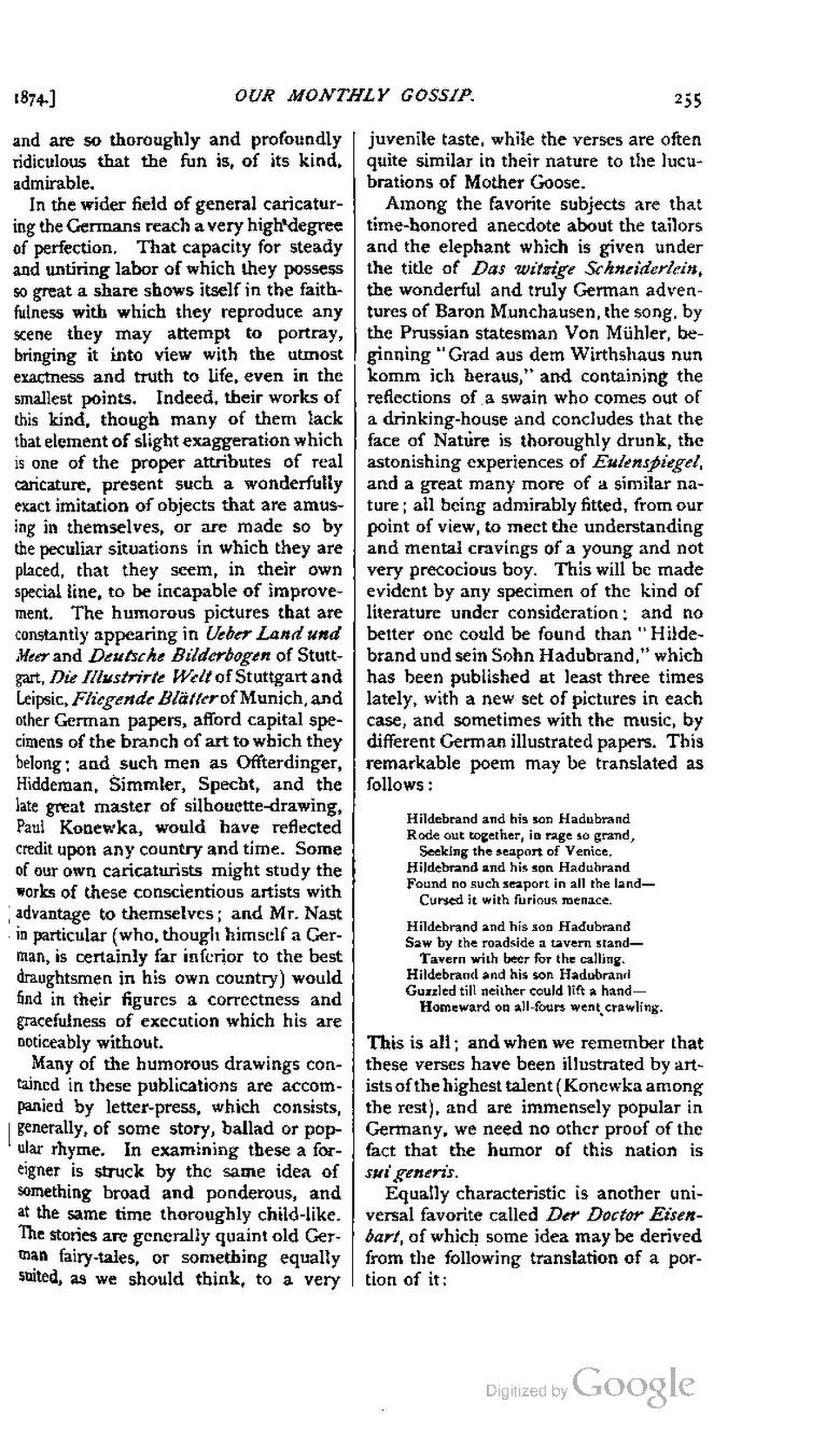and are so thoroughly and profoundly ridiculous that the fun is, of its kind, admirable.
In the wider field of general caricaturing the Germans reach a very high degree of perfection. That capacity for steady and untiring labor of which they possess so great a share shows itself in the faithfulness with which they reproduce any scene they may attempt to portray, bringing it into view with the utmost exactness and truth to life, even in the smallest points. Indeed, their works of this kind, though many of them lack that element of slight exaggeration which is one of the proper attributes of real caricature, present such a wonderfully exact imitation of objects that are amusing in themselves, or are made so by the peculiar situations in which they are placed, that they seem, in their own special line, to be incapable of improvement. The humorous pictures that are constantly appearing in Ueber Land und Meer and Deutsche Bilderhogen of Stuttgart, Die Illustrirte Welt of Stuttgart and Leipsic, Fliegende Blätter of Munich, and other German papers, afford capital specimens of the branch of art to which they belong; and such men as Offterdinger, Hiddeman, Simmler, Specht, and the late great master of silhouette-drawing, Paul Konewka, would have reflected credit upon any country and time. Some of our own caricaturists might study the works of these conscientious artists with advantage to themselves; and Mr. Nast in particular (who, though himself a German, is certainly far inferior to the best draughtsmen in his own country) would find in their figures a correctness and gracefulness of execution which his are noticeably without.
Many of the humorous drawings contained in these publications are accompanied by letter-press, which consists, generally, of some story, ballad or popular rhyme. In examining these a foreigner is struck by the same idea of something broad and ponderous, and at the same time thoroughly child-like. The stories are generally quaint old German fairy-tales, or something equally suited, as we should think, to a very juvenile taste, while the verses are often quite similar in their nature to the lucubrations of Mother Goose.
Among the favorite subjects are that time-honored anecdote about the tailors and the elephant which is given under the title of Das witzige Schneiderlein, the wonderful and truly German adventures of Baron Munchausen, the song, by the Prussian statesman Von Mühler, beginning "Grad aus dem Wirthshaus nun komm ich heraus," and containing the reflections of a swain who comes out of a drinking-house and concludes that the face of Nature is thoroughly drunk, the astonishing experiences of Eulenspiegel, and a great many more of a similar nature; all being admirably fitted, from our point of view, to meet the understanding and mental cravings of a young and not very precocious boy. This will be made evident by any specimen of the kind of literature under consideration; and no better one could be found than "Hildebrand und sein Sohn Hadubrand," which has been published at least three times lately, with a new set of pictures in each case, and sometimes with the music, by different German illustrated papers. This remarkable poem may be translated as follows:
Hildebrand and his son Hadubrand
Rode out together, in rage so grand,
Seeking the seaport of Venice.
Hildebrand and his son Hadubrand
Found no such seaport in all the land—
Cursed it with furious menace.
Hildebrand and his son Hadubrand
Saw by the roadside a tavern stand—
Tavern with beer for the calling.
Hildebrand and his son Hadubrand
Guzzled till neither could lift a hand—
Homeward on all-fours went crawling.
This is all; and when we remember that these verses have been illustrated by artists of the highest talent (Konewka among the rest), and are immensely popular in Germany, we need no other proof of the fact that the humor of this nation is sui generis.
Equally characteristic is another universal favorite called Der Doctor Eisenbart, of which some idea may be derived from the following translation of a portion of it:
